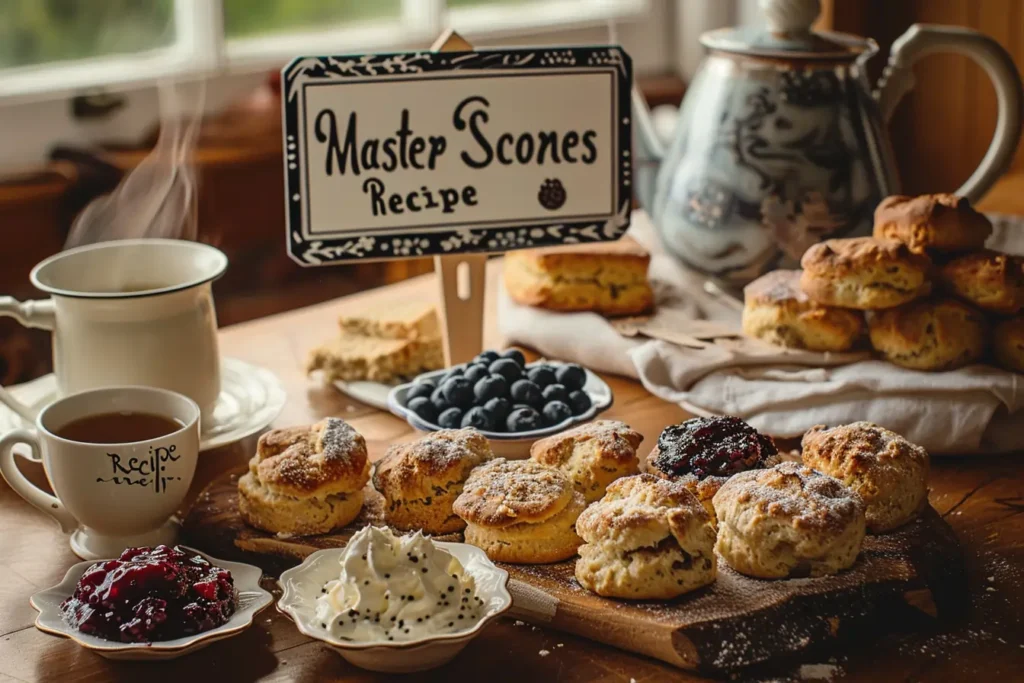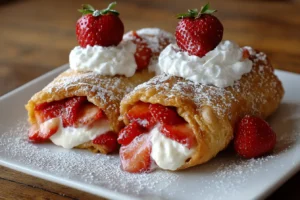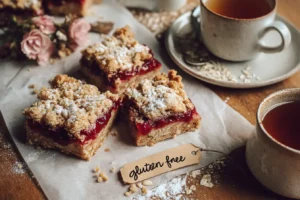I still remember the first time I tried to make scones. I was fresh out of college, convinced that “home baker” was just a vibe and not a skill. I’d found what looked like the perfect master scones recipe online and imagined pulling golden, fluffy scones out of the oven to impress my friends.
Reality check: my dough was more glue than crumb, and by the time the timer buzzed, what I pulled out was basically a tray of edible paperweights. Flat. Rock-hard. The kind of “baked good” that only your most loyal dog would accept—and even she just sniffed it and wandered away.
But honestly? That scone flop was the best thing that could have happened. It made me stubborn (in a good way!) and sent me on a delicious mission: learn every trick, swap, and secret to foolproof, bakery-style scones—no matter how many kitchen fails it took.
Years (and plenty of sticky countertops) later, I’m sharing my ultimate master scones recipe—the one I wish I’d had back when my scones could double as hockey pucks. Whether you’re brand new to baking or a brunch legend looking to up your game, I promise this guide has everything you need for cloud-like, can’t-stop-eating-them scones.
Introduction: Why Master Scones Deserve a Spot in Every Baker’s Kitchen
If you ask me, there’s something almost magical about pulling a tray of fresh, fluffy scones from the oven. Scones are the goldilocks of the baking world: not too sweet, not too fussy, and endlessly customizable. And the best part? Anyone (yes, anyone) can master the art of bakery-style scones at home. No fancy mixer, no special occasion required—just a great master scones recipe, a few clever tips, and a sprinkle of curiosity.
This guide is for every baker who’s ever wanted to make scones that are crisp on the outside, cloud-soft inside, and loaded with personality (just like you!). Whether you’re craving classic cream scones, want to bake up a batch for brunch, or need some gluten-free inspiration, you’ll find all the secrets here. It’s been tested, tasted, and tweaked by bakers of every level—plus, you’ll find plenty of troubleshooting help, fun flavor ideas, and real kitchen stories to keep things honest.
Love cozy weekend baking? You might also enjoy my Bourbon Pecan Sticky Buns or a slice of Cottage Cheese Banana Bread for breakfast. And if you need a fun side for your next brunch, don’t miss my Sweet Potato Waffle Fries.
Ready to discover your new favorite scone? Let’s dive in!
Table of Contents
Table of Contents
What Makes a Master Scone?
What is a Scone?
At its core, a scone is a quick bread—kind of like the lovechild of a biscuit and a muffin. It’s buttery, just sweet enough (unless you’re going savory!), and perfect with a cup of coffee or a spot of tea. Scones come together fast, no yeast or long proofing times required. Just flour, fat, liquid, and your favorite mix-ins.
But let’s be honest: scones can also be heartbreakers. One minute you’re dreaming of fluffy bakery scones, the next you’re gnawing on something that could bounce off the kitchen floor. (Been there, done that, have the crumb-filled hoodie to prove it.)
Why a Master Scones Recipe Matters
Here’s the thing: not all scone recipes are created equal. Some are dry, some spread all over the baking sheet, some just meh. Having a go-to master scones recipe is like keeping a magic trick up your sleeve—ready to impress whenever the craving strikes. It’s the recipe you can riff on a hundred ways, the one that works with berries in summer, chocolate chips in winter, or even cheddar and chives when you’re feeling savory.
Think of it like a little black dress for your brunch table—dress it up, dress it down, always looks (and tastes) amazing.
Pro Tip: Once you have a reliable base, you can make bakery-worthy scones at home—every time.
Key Qualities of Perfect Scones
- Crisp, golden exterior (not burnt!)
- Tender, fluffy crumb inside—never dry or gummy
- Just enough rise for a beautiful split
- Easy to customize with mix-ins, glazes, or toppings
- They taste amazing straight from the oven or hours later—but honestly, nothing beats a scone that’s still
Scone Styles Around the World
- British scones are famously soft and light, often paired with clotted cream and a generous spoonful of jam—the ultimate treat for any afternoon tea.
- American scones tend to be a bit sweeter, typically cut into wedges, and loaded up with extras like chocolate chips, dried fruit, or crunchy nuts.
- Australian Scones: Very close to British but often a bit lighter and fluffier, perfect with whipped cream
- Savory Scones: Popular everywhere—cheese, herbs, even bacon! Breakfast of champions.
Fun Fact: Did you know? The name ‘scone’ is believed to trace back to the Dutch word ‘schoonbrot,’ meaning fine bread. No matter where you’re baking, though, scones are always a symbol of cozy comfort and creativity.
The Master Scones Recipe
Print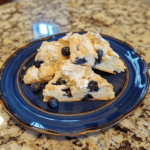
Master Scones Recipe
- Total Time: 30–35 minutes
- Yield: 8 scones 1x
- Diet: Vegetarian
Description
This master scones recipe is your go-to guide for fluffy, bakery-style scones you can make at home. Simple ingredients, endless flavor variations, and clear step-by-step instructions ensure delicious results every time. Perfect for breakfast, brunch, or a cozy teatime treat—plus gluten-free, vegan, and dairy-free options included!
Ingredients
-
2 cups (240g) all-purpose flour (or gluten-free blend)
-
1/3 cup (65g) sugar
-
1 tbsp baking powder
-
1/2 tsp salt
-
1/2 cup (115g) cold unsalted butter (or vegan butter/coconut oil)
-
2/3 cup (160ml) heavy cream or buttermilk (or plant-based milk + 1 tsp lemon juice)
-
1 large egg (or flax egg: 1 tbsp flaxseed + 3 tbsp water, mixed and rested 5 min)
-
1–1.5 cups mix-ins (blueberries, chocolate chips, cheese, dried fruit, etc.)
-
Optional: 1 tsp vanilla extract or lemon zest for extra flavor
Instructions
-
Prep: Preheat oven to 400°F (200°C). Line a baking sheet with parchment paper.
-
Mix Dry Ingredients: In a large bowl, whisk together flour, sugar, baking powder, and salt.
-
Cut in Butter: Grate or cut cold butter into small pieces and work into the flour until the mixture resembles coarse crumbs.
-
Combine Wet Ingredients: In a separate bowl, whisk together cream (or alternative), egg, and vanilla.
-
Make Dough: Pour wet ingredients into dry, add mix-ins, and gently stir until a shaggy dough forms. Do not overmix.
-
Shape: Turn dough onto a floured surface. Pat into a 1-inch thick round. Cut into 8 wedges or use a cutter for circles.
-
Chill: Place scones on the baking sheet and chill in the fridge for 10–15 minutes.
-
Bake: Bake 15–18 minutes, until golden brown and risen. Cool slightly before serving.
Notes
-
Keep all ingredients cold for the fluffiest texture.
-
For dairy-free, use plant-based butter and milk alternatives.
-
Add a simple glaze by mixing powdered sugar with a splash of milk or juice.
-
Scones freeze well—bake from frozen, adding 2–3 minutes to bake time.
-
Swap in whole wheat or half whole wheat flour for extra fiber.
- Prep Time: 15 minutes
- Cook Time: 15–18 minutes
- Category: Breakfast
- Method: Baking
- Cuisine: British/American
Nutrition
- Serving Size: 1 scone
- Calories: 280
- Sugar: 8g
- Sodium: 270mg
- Fat: 14g
- Saturated Fat: 9g
- Unsaturated Fat: 4g
- Trans Fat: 0g
- Carbohydrates: 35g
- Fiber: 1g
- Protein: 5g
- Cholesterol: 55mg
Ready for the only master scones recipe you’ll ever need? Whether you want classic, bakery-style scones, or something a little wild (cheddar and chive, anyone?), this base will become your baking BFF. Let’s break it down, step by step—with photos and plenty of tips, because nobody has time for dry, crumbly fails.
Ingredients & Why They Matter
Every truly great master scones recipe starts with the right ingredients—and a few simple tricks to make them shine. Here’s what you’ll need (plus why each one matters):
- Flour: All-purpose works perfectly for this master scones recipe. If you’re craving extra-light scones, try swapping in some cake flour or mixing it with your usual flour for an even softer crumb.
- Cold butter: The secret to that flaky, tender crumb? Butter straight from the fridge. (Don’t even think about letting it soften!)
- Baking powder: For lift! Make sure it’s fresh.
- Sugar: Just enough for a hint of sweetness. Adjust to taste.
- Salt: Don’t skip it—it wakes up all the flavors.
- Heavy cream or buttermilk: The true stars of a classic, fluffy scone. Cream gives richness; buttermilk brings a light tang and helps keep scones moist.
- Egg: Adds structure and richness (skip for vegan scones—swap below!).
- Optional add-ins: Berries, chocolate chips, dried fruit, nuts, or your own flavor adventure.
Pro Tip: Keep everything cold—especially the butter and cream. It’s the golden rule of every successful master scones recipe!
Step-by-Step Master Scones Recipe
Your Ingredients
- Measure everything in advance and pop your butter in the freezer for 10 minutes if your kitchen is warm.
Mix the Dry Ingredients
- Combine your flour, sugar, baking powder, and salt in a big mixing bowl, giving everything a good whisk to blend the dry ingredients evenly.
Cut in the Cold Butter
- Cut the cold butter into the flour mix using a pastry cutter, your hands, or even a box grater, stopping when the mixture resembles chunky crumbs with bits about the size of peas.
Add the Wet Ingredients
- In a separate bowl, whisk together the cream (or buttermilk) and egg. Add the wet ingredients to the dry, then use a gentle hand to mix just until the dough comes together and looks a bit rough and scraggly.
Add Mix-Ins (Optional)
- Gently fold in your favorite scone mix-ins—don’t overwork the dough!
Shape & Cut
- Turn dough onto a lightly floured surface. Pat into a round, about 1 inch thick. Cut into wedges or use a biscuit cutter for rounds.
Chill Again
- Pop the shaped scones in the fridge or freezer for 10-15 minutes. This helps them hold their shape and gives the best texture.
Bake
- Bake at 400°F (200°C) for 15-18 minutes, or until golden and crisp on top.
Cool & Enjoy
- Let your scones cool for a few minutes, then serve warm (the best part!).
Essential Equipment & Prep
- Large mixing bowl
- Pastry cutter or box grater
- Measuring cups & spoons
- Baking sheet + parchment paper
- Bench scraper (optional, but so handy for shaping!)
Customizing Your Scones: Flavors, Mix-Ins, and Toppings
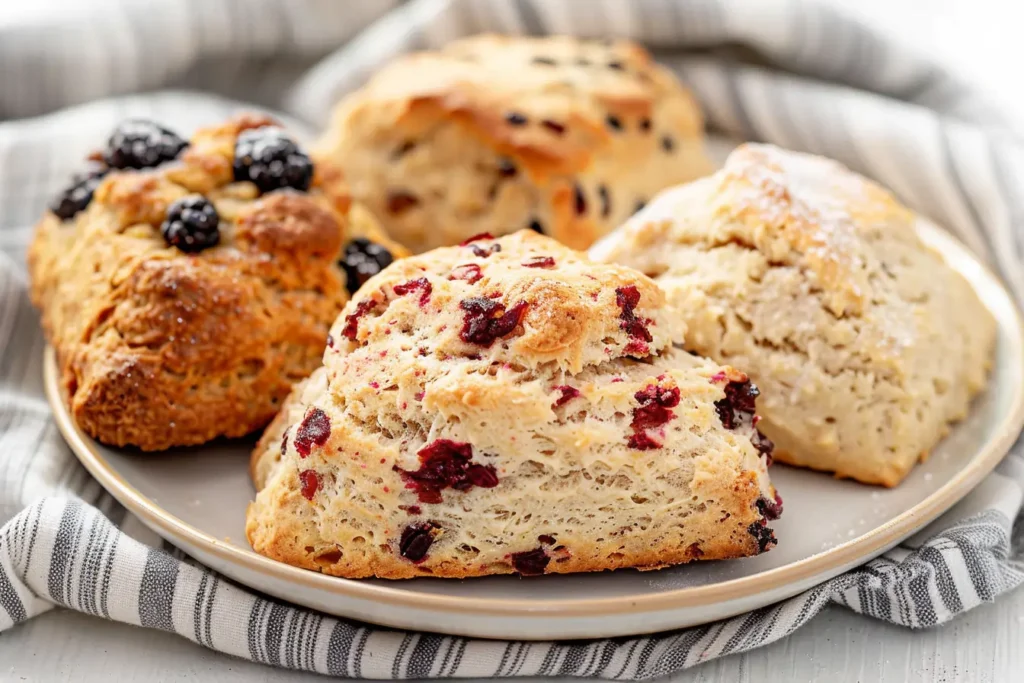
Here’s where the real fun begins! One of the best things about this master scones recipe is how endlessly you can riff on it. Sweet, savory, classic, or bold—there’s a scone for every mood and every baker.
Sweet vs. Savory Scone Variations
- Sweet Scones:
Think fresh berries, chocolate chips, dried fruit, lemon zest, or cozy spices like cinnamon and ginger. Top with a drizzle of glaze, a sprinkle of sugar, or even a dollop of jam. - Savory Scones:
Channel your inner brunch queen! Add shredded cheddar, chives, bacon bits, sun-dried tomatoes, or even a touch of black pepper. Delicious with soups, salads, or just on their own.
Flavor Variation Table
| Flavor Combo | Mix-Ins | Topping/Glaze Idea |
|---|---|---|
| Classic Blueberry Lemon | Fresh blueberries, lemon zest | Lemon glaze |
| Cheddar Chive | Shredded cheddar, chopped chives | Brushed cream, sea salt |
| Cinnamon Raisin | Raisins, cinnamon, brown sugar | Cinnamon sugar sprinkle |
| Triple Chocolate | Chocolate chips, cocoa powder | Chocolate drizzle |
| Maple Walnut | Chopped walnuts, maple syrup | Maple glaze |
| Bacon Jalapeño | Cooked bacon, diced jalapeño | Cheddar, black pepper |
| Cranberry Orange | Dried cranberries, orange zest | Orange glaze |
| Rosemary Parmesan | Fresh rosemary, grated parmesan | Olive oil, cracked pepper |
Pick any combo—or invent your own! This master scones recipe can handle it.
Seasonal & Holiday Scone Ideas
- Spring: Strawberry & white chocolate, lemon poppy seed
- Summer: Peach & basil, fresh blueberry
- Fall: Pumpkin spice, apple cinnamon, maple pecan
- Winter: Cranberry-orange, chocolate peppermint, gingerbread
Flavor Generator
Feeling indecisive?
Pick a mood, pick a season, or just open your pantry. Try this:
- Base: Sweet or savory
- Mix-In #1: Fruit, nut, cheese, herb
- Mix-In #2: Spice, zest, chocolate, more
- Topping: Glaze, sugar, extra cheese, or none
(On your site, this can be an interactive “Scone Flavor Generator” button!)
Toppings, Glazes, and Finishing Touches
- For a sweet crunch, brush the tops of your scones with cream and dust them with turbinado sugar right before they go into the oven.
- Simple Glaze: Mix powdered sugar with milk or juice and drizzle after baking.
- For a savory finish, lightly brush the scones with olive oil or melted butter, then sprinkle on extra cheese, fresh herbs, or a dash of flaky sea salt before baking.
Pro Tip:
No matter your flavor combo, this master scones recipe stays fluffy and tender—just don’t overload with too many wet add-ins!
Scones for Every Diet
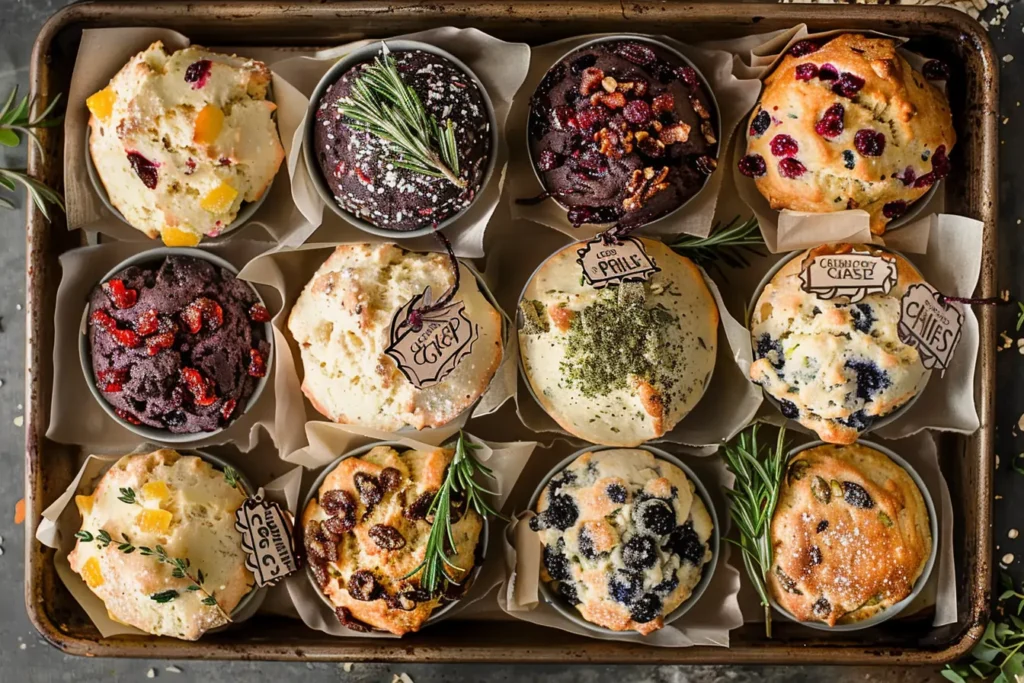
Because everyone deserves a warm, fluffy scone—no matter what’s on your “can’t eat” list. This master scones recipe is flexible, friendly, and ready for any dietary adventure. Below you’ll find classic, gluten-free, vegan, and dairy-free versions, plus allergy-friendly swaps.
Side-by-Side: Classic, Gluten-Free, Vegan & Dairy-Free Scones
| Version | Flour | Fat | Liquid | Binder | Notes |
|---|---|---|---|---|---|
| Classic | All-purpose | Cold butter | Heavy cream or buttermilk | Egg | Original master scones recipe |
| Gluten-Free | GF all-purpose blend | Cold vegan butter or coconut oil | Plant milk (soy, oat, almond) | Flax egg or extra baking powder | Add 1/4 tsp xanthan gum if your blend doesn’t have it |
| Vegan | All-purpose or GF | Cold vegan butter | Plant milk + 1 tsp lemon juice | Flax egg | Add a touch more liquid if dough seems dry |
| Dairy-Free | All-purpose or GF | Cold vegan butter or coconut oil | Plant milk | Egg or flax egg | Use coconut cream for extra richness |
Ingredient Substitution Grid
| Need To Avoid | Use This Instead | Note/Tips |
|---|---|---|
| Butter | Vegan butter, coconut oil | Freeze coconut oil for best flakiness |
| Cream/Buttermilk | Plant-based milk + 1 tsp lemon juice | Adds tang & tenderness |
| Egg | Flax egg (1 tbsp flax + 3 tbsp water) | Let sit 5 min to thicken; good binding |
| Wheat/Gluten | Gluten-free flour blend | Add xanthan gum if not included |
Texture & Taste Comparison
- Classic: Fluffy, rich, “bakery style” crumb—golden, crisp edge.
- Gluten-Free: Slightly more tender and crumbly, but still delicious. Use a high-quality blend for best results.
- Vegan scones turn out airy and soft, with a hint of sweetness—vegan butter gives them the best taste and texture.
- Dairy-Free: Almost identical to classic if you use rich coconut milk or a good vegan substitute.
Pro Tip:
No matter which version you try, keep everything as cold as possible for maximum lift and flakiness—that’s the real secret behind every successful master scones recipe.
Nutrition Facts for the Master Scones Recipe
Curious about what’s inside every fluffy bite of your scones? Here’s the nutrition breakdown for one scone made with the classic master scones recipe—using cream, butter, and without any extra mix-ins or toppings.
| Nutrient | Amount per Scone |
|---|---|
| Calories | 240–300 |
| Total Fat | 12–16g |
| Saturated Fat | 7–10g |
| Carbohydrates | 30–36g |
| Fiber | 1g |
| Sugar | 7–10g (without glaze) |
| Protein | 4–5g |
| Sodium | 250–300mg |
Keep in mind, these numbers are an estimate and will change if you add different mix-ins, glazes, or adapt the master scones recipe to fit your dietary needs. If you want an exact nutrition profile, try using an online nutrition calculator and plug in your exact ingredients from this master scones recipe.
How to Lighten Up Your Master Scones Recipe
If you want to make your master scones recipe a little lighter, here are some easy swaps:
- For a lighter scone that’s still tender, try swapping half the cream for Greek yogurt to cut down on fat while keeping every bite moist.
- Swap in coconut oil or vegan butter for a plant-based take on the classic master scones recipe.
- Reduce the sugar by a tablespoon or two; the master scones recipe is very forgiving.
- Mix in fresh berries or diced apples for natural sweetness and extra fiber.
- Try whole wheat or a gluten-free flour blend to add more nutrition while still following the same master scones recipe steps.
No matter how you tweak it, starting with this master scones recipe ensures your scones will always be fluffy, delicious, and totally customizable for your health and flavor preferences!
Serving, Storing, and Reheating Scones
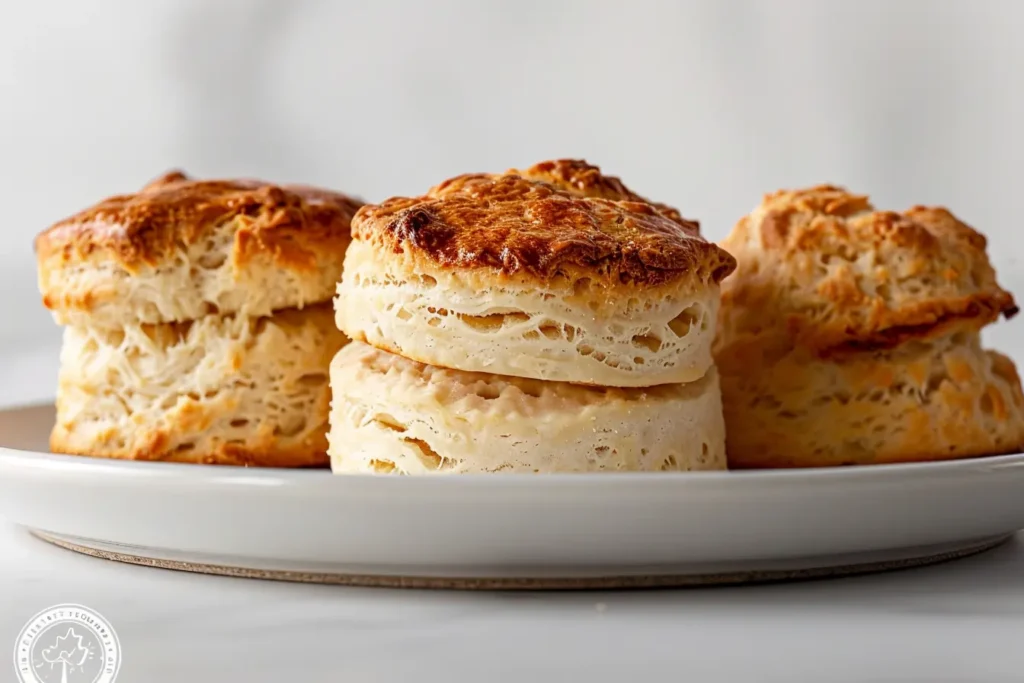
Pairing Ideas: The Best Ways to Enjoy Your Scones
- For a true afternoon tea experience, pair your scones with clotted cream, a spoonful of lemon curd, and your favorite homemade jam.
- Brunch Spread: Pair sweet scones with fruit salad, or serve savory scones alongside scrambled eggs and crispy bacon.
- Coffee Date at Home: Warm scones, strong coffee, your coziest blanket—perfection.
- Soup or Salad Sidekick: Cheddar chive scones are amazing next to a steaming bowl of soup!
Pro Tip: Want bakery vibes? Warm your scones and dust with a little powdered sugar just before serving.
Make-Ahead, Freezing & Reheating Tips
- Make-Ahead: Shape the scone dough, arrange on a baking sheet, and freeze until solid. Transfer to a freezer bag for up to 2 months.
- To Bake from Frozen: No need to thaw—just bake straight from the freezer, adding 2–3 extra minutes to the bake time.
- Freezing Baked Scones: Cool completely, then wrap individually and freeze. Thaw at room temperature or gently reheat.
- Reheating Scones:
- Oven: 5–7 minutes at 325°F (160°C) makes them taste freshly baked.
- Microwave: 10–15 seconds per scone for quick softening (but oven keeps the exterior crisp!).
How to Keep Scones Fresh
- Once your scones have cooled, keep them in an airtight container at room temperature—they’ll stay delicious for up to two days. Slip in a slice of apple or a piece of bread to help keep them moist!
- Fridge: Not recommended, as scones can dry out (unless they have perishable fillings).
- Freezer: Best for longer storage—your future self will thank you.
Creative Uses for Leftover Scones
- Scone Trifle: Cube and layer with yogurt and berries.
- French Toast Scones: Dip halved scones in egg and pan-fry for a breakfast upgrade.
- Ice Cream Sandwiches: Slice scones and fill with your favorite ice cream—trust me.
- Bread Pudding: Use stale scones just like bread for a decadent dessert.
The Science of Fluffy Scones: Troubleshooting & FAQs
If you’ve ever wondered why your scones came out flat, dry, or just “meh”—you’re not alone. Even the best master scones recipe can go sideways if you miss a key step. Don’t worry! We’re busting the biggest scone struggles with science, a quick-fix chart, and answers to your most-Googled scone questions.
Troubleshooting Chart
| Problem | Likely Cause | Quick Fix |
|---|---|---|
| Dry or Crumbly | Overmixed dough, not enough fat/liquid | Mix just until combined, add a splash more cream or milk |
| Flat Scones | Warm butter, overworked dough, old baking powder | Use cold butter, chill dough before baking, fresh leaveners |
| Spread Too Much | Dough too wet, not chilled, too much leavener | Chill scones before baking, measure carefully |
| Tough Texture | Overkneaded dough, too much flour | Mix gently, measure flour using the “spoon & level” method |
| Pale Color | Oven too cool, not enough egg/cream on top | Check oven temp, brush tops with egg wash or cream |
| Gummy Inside | Undercooked or dough too wet | Bake a few minutes longer, check with a toothpick |
Common Mistake:
Warming up your butter or handling dough too much = dense, sad scones. The best master scones recipe starts with cold fat and a gentle hand.
Dough Handling & Resting Tips
- Don’t overmix. As soon as your dough comes together, stop!
- Shape gently. Pat into a round; don’t roll or compress too much.
- Rest the dough. Chill shaped scones for 10–15 minutes before baking for better rise and definition.
High-Altitude & Ingredient Swap Tips
- High Altitude: Increase oven temp by 15–25°F and decrease baking powder slightly. Add a touch more liquid if needed.
- Swapping Flours: If using whole wheat, sub up to 50%—but add an extra tablespoon of cream to keep it moist.
- Mix-Ins: Fold in gently at the end, or they’ll weigh down your dough.
What is the secret to making fluffy scones?
The secret is cold butter, minimal mixing, and a gentle touch. Chilling the dough right before baking is game-changing for flakiness!
How do I prevent my scones from spreading too much?
Chill the shaped scones before baking, and don’t add too much liquid. Also, make sure your baking powder is fresh.
Can I make scone dough ahead and bake later?
Yes! Prepare and shape the dough, cover tightly, and chill up to 12 hours or freeze for longer storage. Bake from cold—just add 2–3 extra minutes.
What are five different types of scones?
Five popular types of scones include:
Classic Cream Scones: Traditional, lightly sweetened, and perfect for tea.
Blueberry Scones: Packed with fresh or dried blueberries for a fruity twist.
Cheddar Chive Scones: Savory, with sharp cheddar cheese and fresh chives.
Chocolate Chip Scones: Sweet and indulgent, great for breakfast or dessert.
Cranberry Orange Scones: Tangy dried cranberries paired with zesty orange flavor.
Each can be made using the same master scones recipe—just switch up the mix-ins for endless variety!
What’s the difference between British and American scones?
British scones are less sweet, round, and often served with clotted cream. American scones are usually wedge-shaped and loaded with mix-ins or glaze.
Conclusion: Your Master Scones Recipe Adventure Starts Here
If you’ve made it this far, you’re officially part of the scone squad! Whether your first batch from this master scones recipe turns out picture-perfect or a little quirky (hey, we’ve all been there), remember: every baker has flops and “aha!” moments. That’s the fun—and the flavor—of baking at home.
The beauty of a truly great master scones recipe is how it grows with you. Maybe you start with classic cream scones, then branch out into wild berry, chocolate chip, or even cheddar-chive scones for Sunday brunch. Each bake is a new adventure, and you’re never baking alone—this community is always here to share ideas, troubleshooting tips, and a little encouragement when your dough gets sticky.
Ready to try your own version? I can’t wait to see the scones you bake, your creative twists, and even those perfectly imperfect kitchen mishaps. check out more cozy baking ideas like my Bourbon Pecan Sticky Buns for next weekend’s treat.
Here’s to fluffy middles, golden tops, and endless possibilities—because with the right master scones recipe, every kitchen moment is worth savoring. Happy baking!
for more recipes follow me in Facebook, Pinterest and medium.
